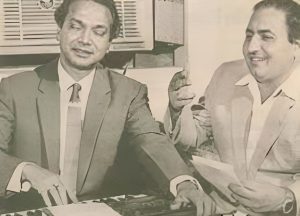Introduction: The Enduring Charm of Vintage Hindi Melodies
 In the intricate tapestry of Bollywood’s musical heritage, Vintage Hindi melodies have left an indelible imprint on the pages of time, enchanting audiences for generations. Their immortality can be attributed to a unique blend of unwavering dedication from the core team – the Lyricist, Music Composer, and Singers – and a commitment to the rules of Ragas by the Music Director. This seamless blend of talent and tradition creates musical masterpieces that resonate profoundly with listeners, leaving a lasting impression on their hearts and spirits. It is this enchanting synergy that ensures the classics of the Golden Era persistently reverberate through the corridors of time.
In the intricate tapestry of Bollywood’s musical heritage, Vintage Hindi melodies have left an indelible imprint on the pages of time, enchanting audiences for generations. Their immortality can be attributed to a unique blend of unwavering dedication from the core team – the Lyricist, Music Composer, and Singers – and a commitment to the rules of Ragas by the Music Director. This seamless blend of talent and tradition creates musical masterpieces that resonate profoundly with listeners, leaving a lasting impression on their hearts and spirits. It is this enchanting synergy that ensures the classics of the Golden Era persistently reverberate through the corridors of time.
Baiju Bawra’s Iconic Devotional Gem: Man Tarpat Hari Darshan Ko Aaj
A shining example of this timeless magic is the 1952 classic Baiju Bawra, specifically the soul-stirring composition “Man Tarpat Hari Darshan Ko Aaj …”. This song was crafted for a poignant moment where Baiju longs to see his guru, hindered by illness, while the guru, Swami Haridas, struggles to reach the temple to catch a glimpse of his beloved Lord Krishna. The song becomes a powerful vessel for Baiju’s intense emotions, articulating his yearning to behold his lord.
A Testament to India’s Unity in Diversity
What renders this devotional gem even more extraordinary is the diverse composition team behind it – all members were of the Muslim faith. Penned by Shakeel Badayuni, composed by Naushad Ali, and delivered with divine resonance by the legendary Mohammed Rafi, this song stands as a profound testament to the secular character of the film industry and the unity in diversity of India. It beautifully showcases how artistic collaboration transcends religious boundaries.
The Unexpected Shift: Talat Mehmood to Mohammed Rafi
Curiously, the initial choice for this profound rendition was the illustrious Talat Mehmood. However, destiny took an unexpected turn when Naushad Ali, the composer, witnessed Talat Mehmood smoking inside the studio — an act perceived as disrespectful to the sanctity of music. Instantly offended, Naushad replaced Talat Mehmood with Mohammed Rafi, marking a pivotal shift that would lead to one of Hindi cinema’s most revered recordings.
The Spiritual Preparation and Raag Malkauns
The day before the scheduled recording, Naushad Ali insisted that the entire team perform their ablutions, emphasizing the need for a cleansed body and a pure mind. Malkauns, a solemn and contemplative Raag predominantly in Mandra Saptak and composed in Vilambit laya, was chosen as the foundational melody for this divine composition. This choice underscored the song’s spiritual depth and the reverence intended for its rendition.
Rafi’s Profound Immersion and its Impact
During the recording, it is said that Mohammed Rafi immersed himself so profoundly in the song that everyone present was left in awe. Observing the enchantment unfold, even Lallu bhai, the unit staff responsible for disbursing payments, found himself chanting “Krishna Krishna” and wandering through the studio in a trance. Mohammed Rafi’s unwavering dedication to this song created a masterpiece with unparalleled quality to this day. The transcendence of his performance was so profound that even he deemed it impossible to recreate the divine magic.
Conclusion: Rafi’s Ascent and an Enduring Legacy
With the release of Baiju Bawra, Mohammed Rafi soared to a prominent position in the playback universe, cementing his legacy as one of the greatest voices in the annals of Hindi Cinema. “Man Tarpat Hari Darshan Ko Aaj” remains a timeless testament to his unmatched vocal artistry and the power of music to evoke profound spiritual emotion.
Our next article will explore how a Singing Maestro can exhibit his brilliance despite limited verses in a song.
~ Balwant S. Wadhwani
